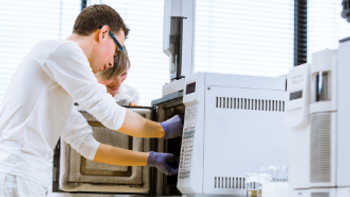
GC✕GC–TOF-MS Used with F-ratio Analysis to Evaluate Volatiles in Getter Substrate Breakdown
Researchers have used comprehensive two-dimensional gas chromatography with time of flight mass spectrometry and Fisher-ratio analysis to evaluate the breakdown of organic-based getters used to absorb gases and vapors from their surroundings.
Researchers at Los Alamos National Laboratory in Los Alamos, NM have published a study in the Journal of Chromatography A that improves upon the use of gas chromatography coupled to mass spectrometry (GC–MS) to understand hydrogen uptake by organic-based getters, by instead deploying comprehensive two-dimensional gas chromatography with time of flight mass spectrometry (GC✕GC–TOF-MS) and Fisher-ratio (F-ratio) analysis to separate and classify volatile mixtures released during decomposition (1).
Organic-based getters are materials that can absorb gases and vapors from their surroundings. These materials are typically made of a porous organic polymer or a hybrid organic-inorganic network. Getters are seen as a cost-effective way to mitigate unwanted reactions and, when made of organic materials, can reduce hydrogen gas accumulation. If hydrogen is not eliminated, it can cause hydriding corrosion, embrittlement of materials, and degradation of electronic materials.
The main advantage of GC✕GC–TOF-MS with respect to one-dimensional gas chromatography (1D-GC) is an improvement in peak capacity, or how many compounds can be separated in a given time period, by a factor of 10 while keeping a constant run time. The technique is especially useful for the analysis of organic-based getters, which may be too complex for 1D-GC to sufficiently separate.
Because GC✕GC–TOF-MS presents challenges in viewing three-dimensional data and identifying statistically relevant chemical changes to samples not known a priori, the further use of chemometric software such as F-ratio analysis allows for the identification of compounds either generated or consumed during the hydrogenation process. F-ratio, a supervised, non-targeted technique defined as class-to-class variation of a detected signal divided by the sum of within-class variations of that signal, may be used to mark chemical differences of hydrogenated versus non-hydrogenated DEB getters.
Taking as an example a getter such as 1,4-bis(phenylethynyl)benzene (DEB) combined with a palladium(0)bis(dibenzylideneacetone) (Pd(dba)2) catalyst, the researchers examined the presence of volatiles released in the breakdown of those or substrate materials which could interact with other sensitive materials and cause them to deteriorate. Further, they sought to understand whether different substrates cause a getter or catalyst to degrade in different ways.
Samples used in the study included a getter infused silicone foam, a hydrogenated getter infused silicone foam, an activated carbon getter pellet, and a hydrogenated activated carbon getter pellet. The combination of the GC✕GC–TOF-MS and F-ratio analyses found benzene derivatives such as bibenzyl, benzaldehyde, and vinyl benzoate in the activated carbon pellets and 1,5-diphenyl-3-pentatone, toluene, styrene, and 1–1’(2-pentene 1,5-diyl)bis benzene in the silicone foams, and alkane-alkene derivatives like undecane, 4-tridecene, and decane in the pellets and 2,6-dimethyl undecane in the foams.
The researchers found that, as hypothesized, a comparison of the hydrogenated getter substrates made possible by these processes altered the degradation byproducts of DEB and Pd(dba)2, and did so to significant enough effect to meaningfully expand on limited previous research and demonstrate the superior efficacy of GC✕GC–TOF-MS over less advanced methods.
Reference
(1) Davis, J.T.; Beaux, M.F. II; Freye, C.E. Evaluation of different getter substrates using two-dimensional gas chromatography with time of flight mass spectrometry. J. Chromatogr. A 2023, 1689, 463760. DOI:
Newsletter
Join the global community of analytical scientists who trust LCGC for insights on the latest techniques, trends, and expert solutions in chromatography.




